AUDI R8 SPYDER 2012 Owners Manual
Manufacturer: AUDI, Model Year: 2012, Model line: R8 SPYDER, Model: AUDI R8 SPYDER 2012Pages: 236, PDF Size: 59.24 MB
Page 131 of 236
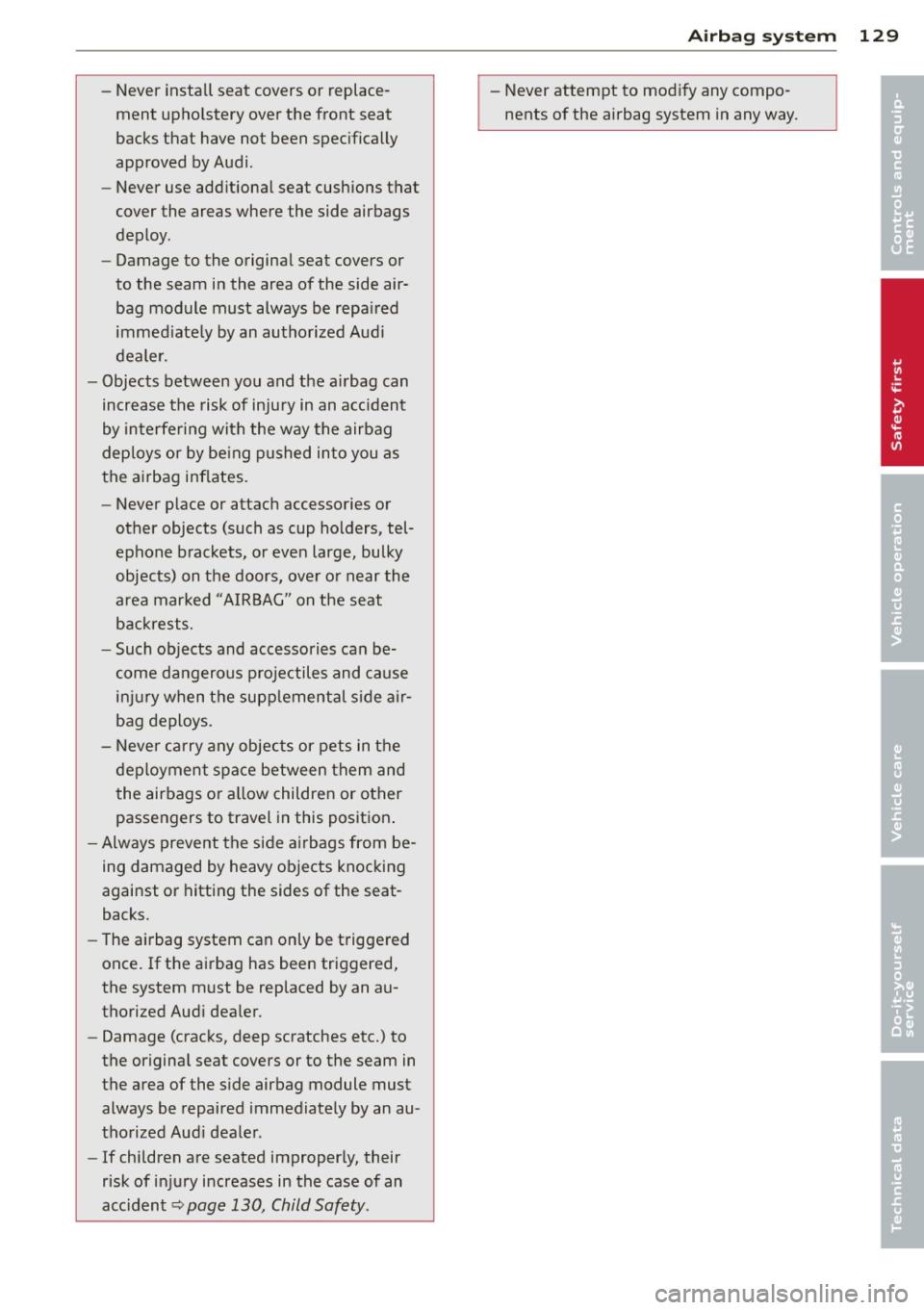
-Never install seat covers or replace
ment upholstery over the front seat
backs that have not been specifically
approved by Audi .
- Never use additional seat cushions that
cover the areas where the side airbags
deploy.
- Damage to the original seat covers or
to the seam in the area of the side air bag module must always be repaired
immediately by an authorized Audi
dealer.
- Objects between you and the airbag can
increase the risk of injury in an accident
by interfering with the way the airbag
deploys or by being pushed into you as
the airbag inflates.
- Never place or attach accessories or
other objects (such as cup holders, tel
ephone brackets, or even large, bulky
objects) on the doors, over or near the
area marked "AIRBAG" on the seat
backrests.
- Such objects and accessories can be
come dangerous projectiles and cause
injury when the supplemental side air
bag deploys.
- Never carry any objects or pets in the
deployment space between them and
the airbags or allow children or other
passengers to travel in this position.
- Always prevent the side airbags from be
ing damaged by heavy objects knocking
against or hitting the sides of the seat
backs.
- The airbag system can only be triggered
once. If the airbag has been triggered,
the system must be replaced by an au
thorized Audi dealer.
- Damage (cracks, deep scratches etc.) to
the original seat covers or to the seam in
the area of the side airbag module must always be repaired immediately by an au
thorized Audi dealer .
- If children are seated improperly, their
risk of injury increases in the case of an
accident ~
page 130, Child Safety .
Airbag system 129
-Never attempt to modify any compo
nents of the airbag system in any way .
•
•
Page 132 of 236
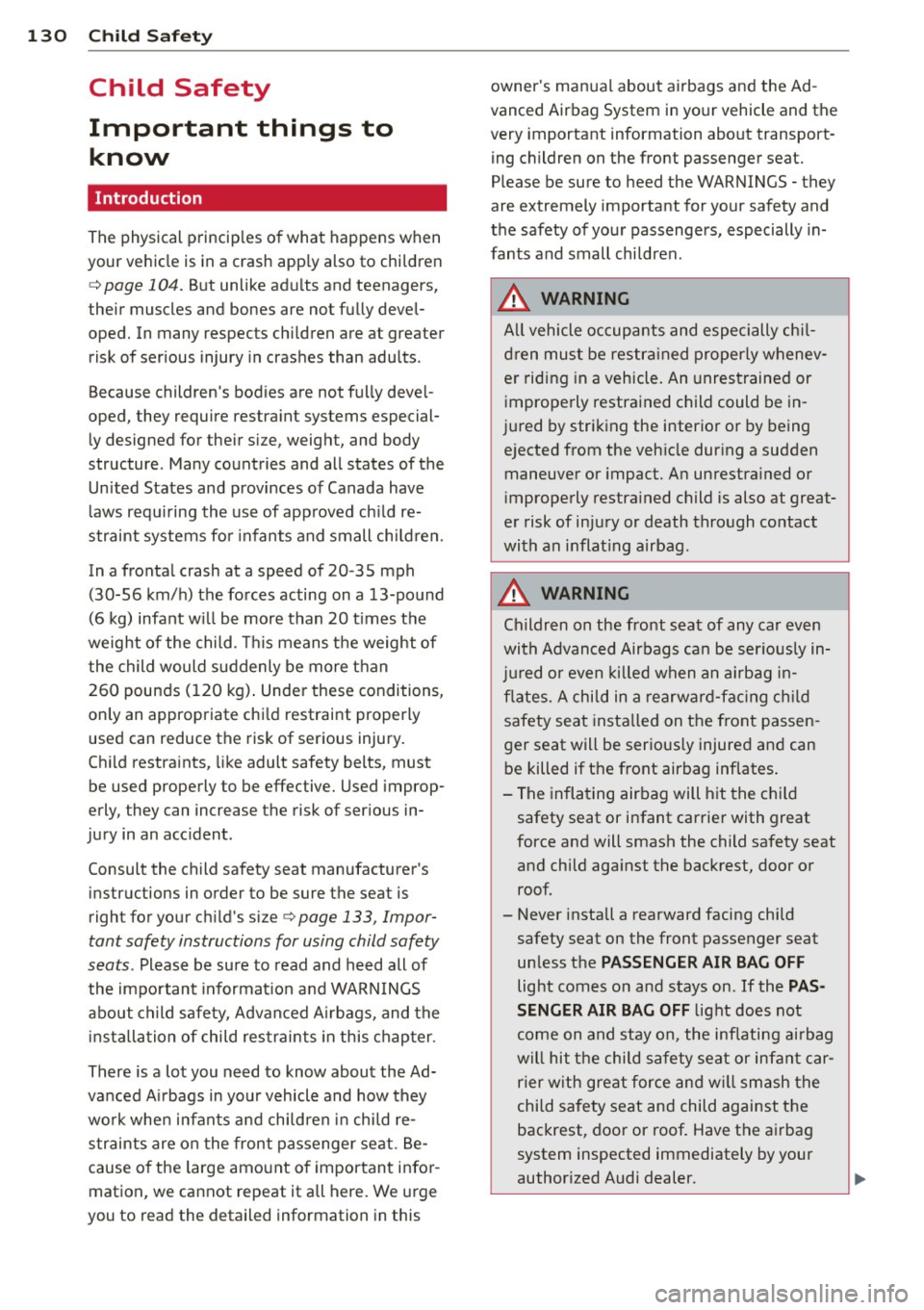
130 Child Saf ety
Child Safety
Important things to
know
Introduction
The physical princip les of what happens when
your vehicle is in a crash app ly also to children
¢ page 104. But unlike adu lts and teenagers,
their muscles and bones are not fully devel
oped. In many respects children are at greater risk of serious injury in crashes than adults .
Because children's bodies are not fully deve l
oped, they require restraint systems especial ly designed for their size, weight, and body
structure. Many countries and all states of the United States and provinces of Canada have
l aws requiring the use of approved ch ild re
straint systems fo r infants and small child ren.
In a frontal crash at a speed of 20-35 mph
(30-56 km/h) the forces acting on a 13-pound
(6 kg) infant w ill be more than 20 times the
weight of the child. T his means the weight of
the child would s uddenly be more than
260 pounds (120 kg) . Under these conditions,
only an appropriate chi ld restraint properly
used can reduce the risk of serious injury.
Child restraints, like adult safety belts, must
be used properly to be effective. Used improp
erly, they can increase the risk of serious in
jury in an acc ident.
Consult the child safety seat manufacturer's instructions in order to be sure the seat is
right for your child's size¢
page 133, Impor
tant safety instructions for using child safety
seats .
Please be sure to read and heed all of
the important informat ion and WARN INGS
about child safety, Advanced A irbags, and the
installation of child restraints in this chapter.
There is a lot you need to know about the Ad
vanced A irbags in your vehicle and how they
work when infants and children in chi ld re
straints are on the front passenger seat. Be
cause o f the large amount of important info r
mation, we cannot repeat it all here. We urge
you to read the detailed information in this owner
's manual about airbags and the Ad
vanced Airbag System in your vehicle and the
very important information about transport
ing children on the front passenger seat.
Please be sure to heed the WARNINGS - they
are extremely important for your safety and
the safety of your passengers, especially in
fants and small children.
.&, WARNING
-
All vehicle occupants and especially chi l
dren must be restra ined properly whenev
er riding in a vehicle. An unrestrained or
improperly restrained child could be in
jured by strik ing the interior or by being
ejected from the vehicle during a sudden maneuver or impact. An unrestra ined or
i mproperly restra ined child is also at great
er risk of injury or death through contact
with an inflat ing airbag.
.&, WARNING
--Children on the front seat of any car even
with Advanced Airbags can be ser iously in
jured or even killed when an airbag in
flates. A child in a rearward-fac ing ch ild
safety seat installed on the front passen
ger seat will be seriously injured and can
be killed if the front airbag inflates.
- The inflating airbag will hit the child
safety seat or infant carrier with great
force and will smash the child safety seat
and child against the backrest, door or roof.
- Never install a rearward facing child safety seat on the front passenger seat
unless the
PASSENGER AIR BAG OFF
light comes on and stays on . If the PAS
SENGER AIR BAG OFF
l ight does not
come on and stay on, the inflating airbag
will hit the child safety seat or infant car
rier w ith great force and will smash the
child safety seat and child against the backrest, door or roof. Have the airbag
system inspected immediately by your
authorized Audi dealer.
Page 133 of 236
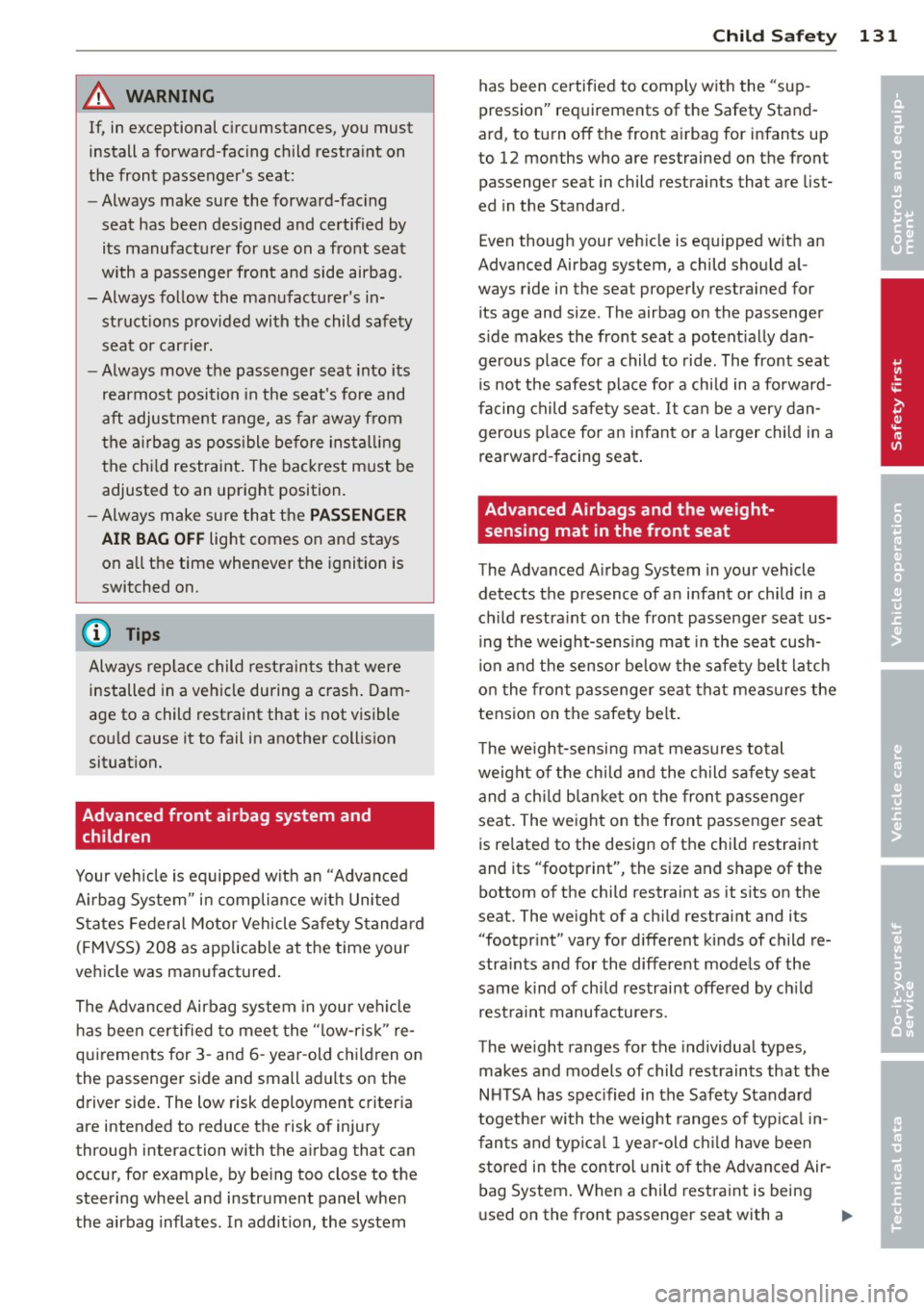
A WARNING
-=
If, in exceptional circumstances, you must
install a forward-facing child restraint on
the front passenger's seat:
- Always make sure the forward-facing
seat has been designed and certified by
its manufacturer for use on a front seat
with a passenger front and side airbag.
-Always follow the manufacturer's in
structions provided with the child safety
seat or carrier.
- Always move the passenger seat into its
rearmost position in the seat's fore and
aft adjustment range, as far away from
the airbag as possible before installing
the child restraint. The backrest must be
adjusted to an upright position.
- Always make sure that the
PASSENGER
AIR BAG OFF light comes on and stays
on all the time whenever the ignition is
switched on.
(D Tips
Always replace child restraints that were
installed in a vehicle during a crash. Dam
age to a child restraint that is not visible
could cause it to fail in another collision
situation.
Advanced front airbag system and children
Your vehicle is equipped with an "Advanced
Airbag System" in compliance with United
States Federal Motor Vehicle Safety Standard
(FMVSS) 208 as applicable at the time your
vehicle was manufactured.
The Advanced Airbag system in your vehicle
has been certified to meet the "low-risk " re
quirements for 3- and 6- year-old children on
the passenger side and small adults on the
driver side. The low risk deployment criteria
are intended to reduce the risk of injury
through interaction with the airbag that can
occur, for example, by being too close to the
steering wheel and instrument panel when
the airbag inflates. In addition, the system
Child Safety 131
has been certified to comply with the "sup
pression" requirements of the Safety Stand
ard, to turn off the front airbag for infants up
to 12 months who are restrained on the front passenger seat in child restraints that are list
ed in the Standard .
Even though your vehicle is equipped with an
Advanced Airbag system, a child should al
ways ride in the seat properly restrained for
its age and size . The airbag on the passenger
side makes the front seat a potentially dan
gerous place for a child to ride. The front seat
is not the safest place for a child in a forward
facing child safety seat .
It can be a very dan
gerous place for an infant or a larger child in a
rearward-facing seat.
Advanced Airbags and the weight
sensing mat in the front seat
The Advanced Airbag System in your vehicle
detects the presence of an infant or child in a
child restraint on the front passenger seat us
ing the weight-sensing mat in the seat cush
ion and the sensor below the safety belt latch
on the front passenger seat that measures the
tension on the safety belt.
The weight-sensing mat measures total
weight of the child and the child safety seat
and a child blanket on the front passenger
seat. The weight on the front passenger seat
is related to the design of the child restraint
and its "footprint", the size and shape of the
bottom of the child restraint as it sits on the
seat. The weight of a child restraint and its
"footprint" vary for different kinds of child re
straints and for the different models of the
same kind of child restraint offered by child restraint manufacturers.
The weight ranges for the individual types,
makes and models of child restraints that the
NHTSA has specified in the Safety Standard
together with the weight ranges of typical in
fants and typical 1 year-old child have been
stored in the control unit of the Advanced Air
bag System. When a child restraint is being
used on the front passenger seat with a
ll-
•
•
Page 134 of 236
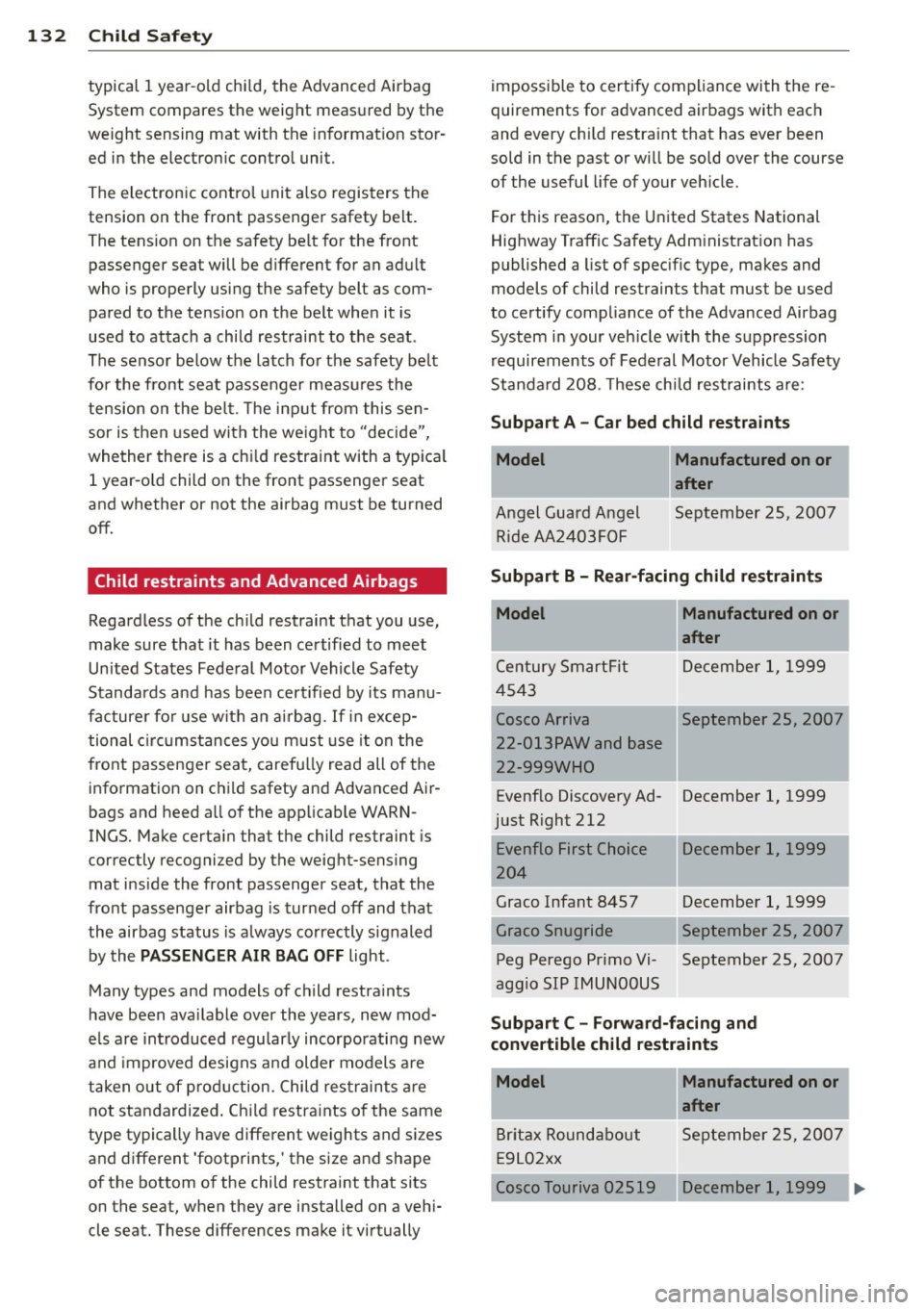
132 Child Saf ety
typical 1 year -old chi ld, the Advanced Airbag
System compares the weight meas ured by the
weight sensing mat with the in format ion stor
ed in the electron ic contro l unit.
The electron ic contro l unit a lso registers the
tension on the front passenge r safety belt.
The tens ion on the safety be lt fo r the front
passenger seat will be d ifferent for an adult
who is properly using the safety belt as com
pared to the tension on t he be lt whe n it is
used to attach a child restraint to the seat.
The senso r below the latch fo r the safety be lt
fo r the front seat passenger measu res the
tension on the be lt. T he inp ut from this sen
sor is then used with the we igh t to "decide",
whether there is a chi ld restraint with a typica l
1 year-o ld child o n the front passenger seat
and whether or not the airbag must be turned
off.
Child restraints and Advanced Airbags
Regardless of the ch ild restraint that you use,
make sure tha t it has been ce rtified to meet
Un ited States Fede ral Motor Vehicle Safety
S tanda rds a nd has been cer tified by its manu
facture r fo r u se wit h an air bag. If i n excep
tional circumstances yo u m ust use it on the
front passenge r seat, caref ully read all of the
info rmation on c hild safety an d Advanced Air
bags and heed a ll of the app licable WARN
INGS. Make certai n that t he child restraint is
correctly recognized by the weig ht-sensing
mat i nside the front passenger seat, that the
fro nt passenge r airbag is tur ned off and that
the airbag status is a lways correctly signaled
by the
PASSENGER AIR BAG OFF light .
Many types and models of child restra ints
have been ava ilable over the years, new mod
e ls ar e introduced regularly incorporat ing new
a nd improved designs a nd older models are
taken out of p ro du ction. Child res traints are
not stan dardized . Ch ild restra ints o f the same
type typically have different weights and s izes
a nd d ifferent 'footprints,' the s ize and s hape
of the bottom o f the child restraint that sits
on the seat, when they are installed on a veh i
cle seat. These differences make it virtually impossible to certify compliance wi
th t he re
quirements for a dvanced airbags with eac h
and every ch ild restra int that has ever been
sold in the past or wi ll be sold over the course
of the useful life of your veh icle.
For t his reason, the United States National
Hig hway T raffic Safety Adm inistrat ion has
published a list of spec ific type, ma kes and
m odels of child restraints that must be used
to certify comp liance of the Advanced Airbag
System i n your veh icle w ith the su ppr ession
r equirem ents of Federal Motor Vehicle Safety
Standa rd 208. These chi ld restraints a re :
Subpart A -Car bed child restraints
Model
Angel Guard Angel
R ide AA 2403F OF Manufactured on or
after
September 25, 2007
Subpart B - Rear-facing child restraints
Model
Century Sm art Fi t
4 543
Cosco Arriva
22 -013PAW and base
22-999 WHO
Evenflo Discove ry Ad
just Right 212
E venflo First Choice
2 04
Graco Infant 8457
G raco Snug ride
Peg Perego Pr im o Vi
aggio SIP IMU NOOUS Manufactured on or
after
D ecembe r 1, 1999
Septemb er 25, 20 07
Decembe r 1, 1999
D ecember 1, 1 999
Decembe r 1, 1999
September 25, 2007
September 25, 2007
Subpart C -Forward-facing and
convertible child restraints '
.
'
.
Model Manufactured on or
·
B rita x Round about
E 9 L0 2xx after
Sep
tember 25, 2007
Cosco Touriva 02519 Decemb er
1, 1999
'
Page 135 of 236
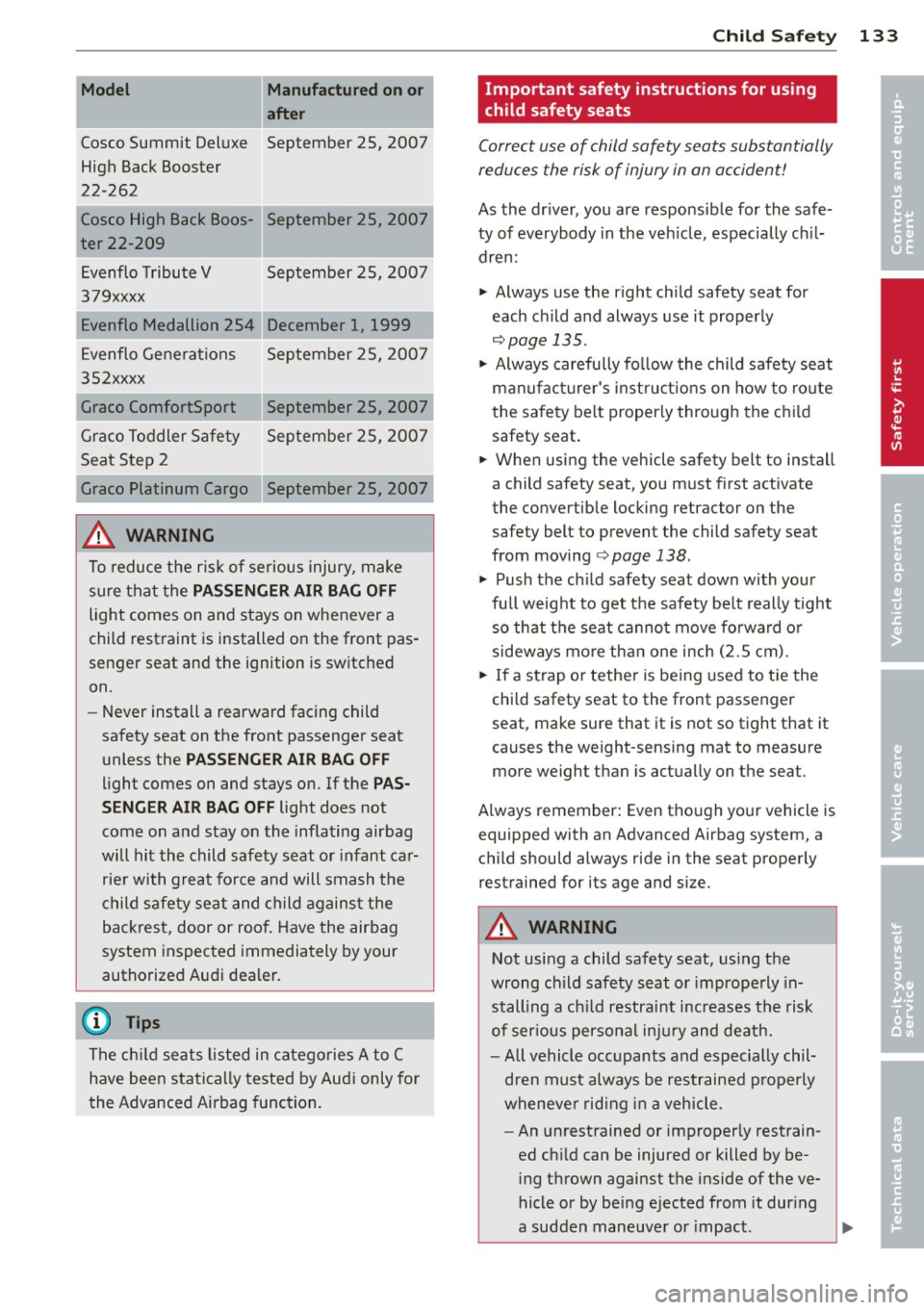
Model Manufactured on or
after
Cosco Summit Deluxe September 25, 2007
H igh Back Bo oste r
22-262
Co sco High Bac k Boos -September 2S, 2007
ter 22- 209
Evenfl o Tribut e V
379xxxx September 25, 2007
December 1, 1999
E
venflo Genera tions September 25, 2007
35 2xxxx
Grace ComfortSport September 2S, 2007
Grace Toddler Sa fety September 25, 200 7
Seat Step 2
Graco Platinum Cargo September 25, 2007
A WARNING
T o reduce the risk of serious injury, make
sure that the
PASSENGER AIR BAG OFF
light comes on and stays on whenever a
child rest raint is installed on the front pas
senger seat and the ignition is switched
on.
- Never install a rearward facing child
safety seat on the front passenger seat
unless the
PASSENGER AIR BAG OFF
light comes on and stays on. If the PAS
SENGER AIR BAG OFF
light does not
come on a nd stay on the inflating airbag
will hit the child safety seat o r infant ca r
rie r wi th great fo rce and will smash the
c hild s afety seat and child agains t the
backrest, door or roof . Have the airbag
system inspected immedia tely by your
authorized Audi dealer.
(D Tips
The ch ild seats listed in catego ries A to C
have been sta tica lly tested by Au di only for
the Advanced Airbag function.
.
Child Sa fet y 133
Important safety instructions for us ing
child safety seats
Correct use of child safety seats substantially
reduces the risk of injury in an accident!
As the dr iver, you are respons ible for the safe
ty of everybody in the veh icle , especially ch il
dren:
"' Always use the r ight ch ild safety seat for
each child and always use it properly
r=;, page 135.
"' Always carefully fo llow the child safe ty seat
manufac turer's inst ruct io ns on how to ro ute
the sa fe ty be lt properly through the c hild
safety seat .
.. When using the vehicle safety belt to install
a child safety seat, you m ust first activate
the convertible locking retractor on the
safety belt to prevent the child safety seat
from mov ing
¢ page 138 .
"' Push the ch ild safety seat down with you r
full weight to get the safety be lt really tight
so that the seat cannot
move fo rwa rd o r
sideways more th an one inch
(2.5 cm).
"' If a st rap or tethe r is be ing used to tie the
child safety seat to the front passenger
seat, make sure that it is not so tight that it
causes the weight-sensing mat to measure
more weight than is act ually on the seat.
A lways remember : Even tho ugh yo ur vehicle is
equipped with an Advanced Airbag system, a
c hi ld should always ride in the seat properly
restrained for its age and s ize.
A WARNING
N ot using a child safety seat, using the
wrong ch ild safety seat o r imprope rly in
stalling a ch ild restraint increases the risk
of ser ious persona l inju ry and death.
- All vehicle occupants and especially chil
dren must always be restrained p rope rly
wheneve r riding in a vehicle.
-
- An unrest rained or improper ly restrain
ed ch ild can be injured or killed by be
i ng t hrown against the ins ide of the
ve
hicle or by being e jected from it dur ing
a sudden maneuve r o r i mpact .
•
•
Page 136 of 236
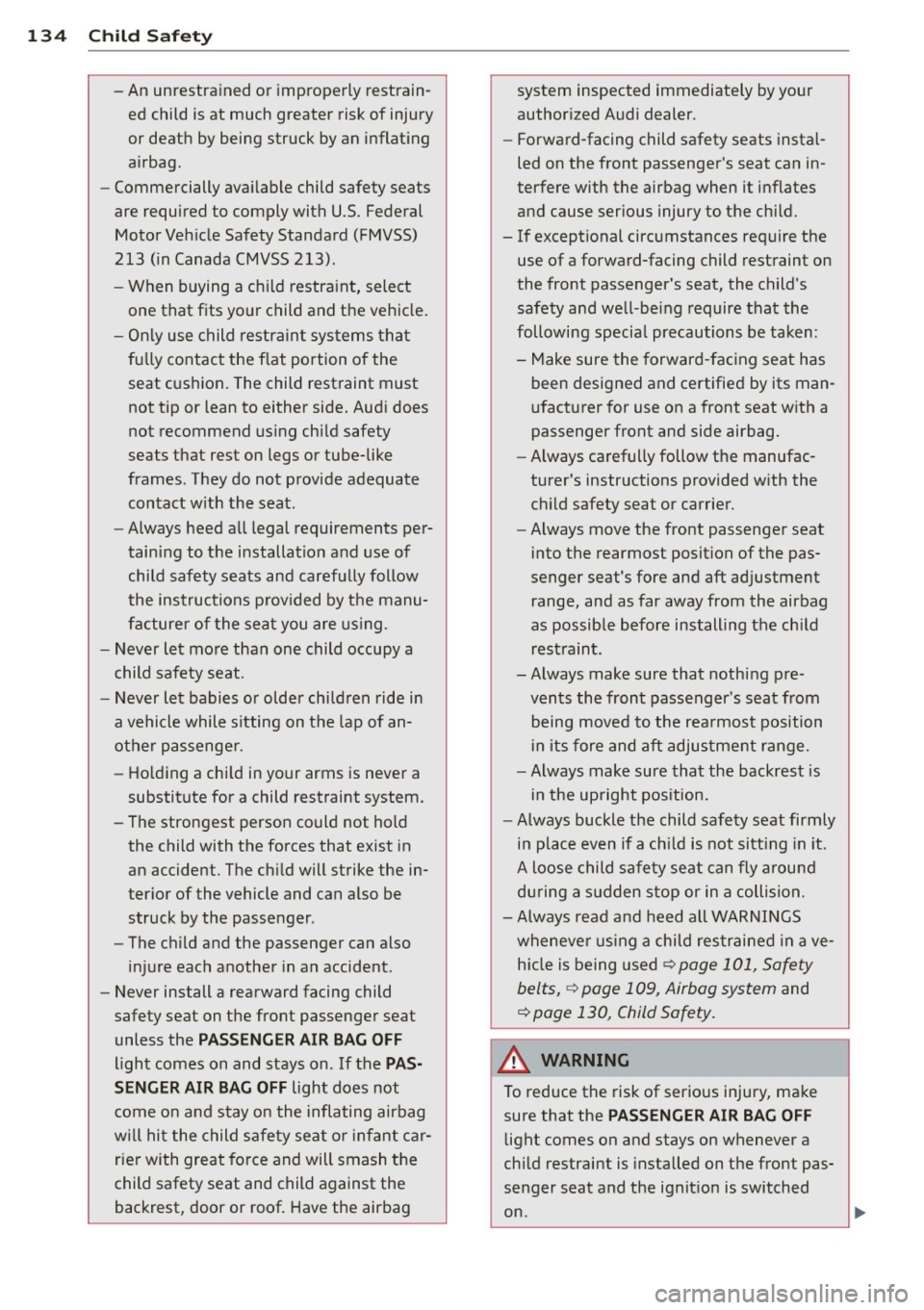
134 Child Safety
-An unrestrained or improperly restrain
ed child is at much greater risk of injury
or death by being struck by an inflating
airbag .
- Commercially available child safety seats
are required to comply with U.S. Federal
Motor Vehicle Safety Standard (FMVSS)
213 (in Canada CMVSS 213).
- When buying a child restraint, select
one that fits your child and the vehicle.
- Only use child restraint systems that
fully contact the flat portion of the
seat cushion. The child restraint must
not tip or lean to either side. Audi does
not recommend using child safety
seats that rest on legs or tube-like
frames . They do not provide adequate
contact with the seat .
- Always heed all legal requirements per
taining to the installation and use of
child safety seats and carefully follow
the instructions provided by the manu
facturer of the seat you are using.
- Never let more than one child occupy a
child safety seat.
- Never let babies or older children ride in
a vehicle while sitting on the lap of an
other passenger.
- Holding a child in your arms is never a
substitute for a child restraint system.
- The strongest person could not hold
the child with the forces that exist in
an accident. The child will strike the in
terior of the vehicle and can also be
struck by the passenger .
- The child and the passenger can also
injure each another in an accident.
- Never install a rearward facing child
safety seat on the front passenger seat
unless the
PASSENGER AIR BAG OFF
light comes on and stays on. If the PAS
SENGER AIR BAG OFF
light does not
come on and stay on the inflating airbag
will hit the child safety seat or infant car
rier with great force and will smash the
child safety seat and child against the
backrest, door or roof. Have the airbag system inspected immediately by your
authorized Audi dealer.
- Forward-facing child safety seats instal
led on the front passenger's seat can in
terfere with the airbag when it inflates
and cause serious injury to the child.
- If exceptional circumstances require the
use of a forward-facing child restraint on
the front passenger's seat, the child's
safety and well -being require that the
following special precautions be taken :
- Make sure the forward-facing seat has
been designed and certified by its man
ufacturer for use on a front seat with a
passenger front and side airbag.
- Always carefully follow the manufac
turer's instructions provided with the
child safety seat or carrier.
- Always move the front passenger seat
into the rearmost position of the pas
senger seat 's fore and aft adjustment
range, and as far away from the airbag
as possible before installing the child
restraint.
- Always make sure that nothing pre
vents the front passenger's seat from
being moved to the rearmost position
in its fore and aft adjustment range.
- Always make sure that the backrest is
in the upright position.
- Always buckle the child safety seat firmly
in place even if a child is not sitting in it.
A loose child safety seat can fly around
during a sudden stop or in a collision.
- Always read and heed all WARNINGS
whenever using a child restrained in ave
hicle is being used¢
page 101, Safety
belts,
¢ page 109, Airbag system and
~ page 130, Child Safety .
A WARNING ~
To reduce the risk of serious injury, make
sure that the
PASSENGER AIR BAG OFF
light comes on and stays on whenever a
child restraint is installed on the front pas
senger seat and the ignition is switched
on.
Page 137 of 236
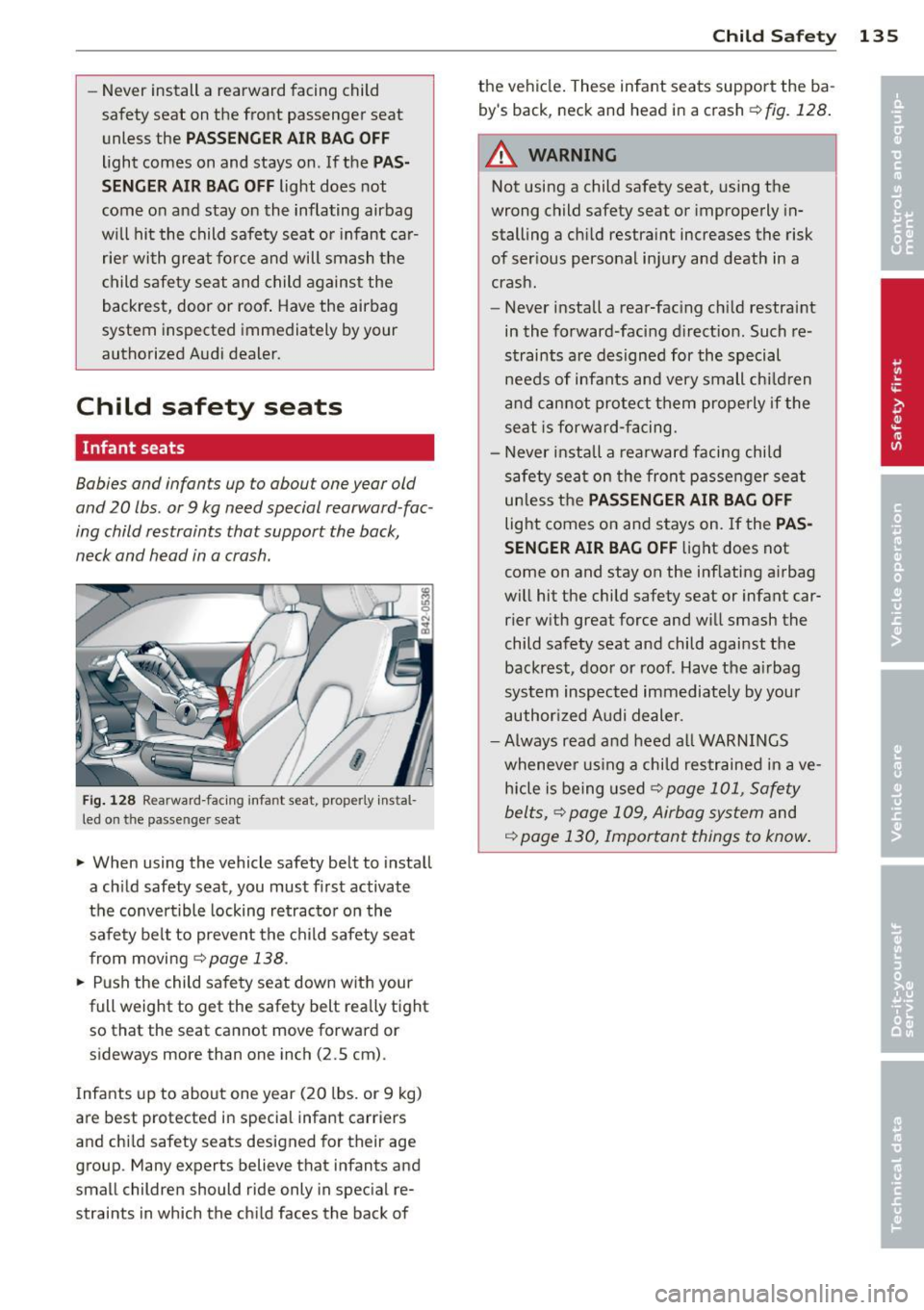
-Never install a rearward facing child
safety seat on the front passenger seat
unless the
PAS SENGER AIR BA G OFF
light comes on and stays on . If the PA S
SEN GER AI R BAG OFF
light does not
come on and stay on the inflating airbag
will hit the child safety seat o r infant car
r ie r with great fo rce and will smash the
child safety seat and child against the
backrest, door or roof . Have the airbag
system inspected immediately by your authorized Audi dealer .
Child safety seats
Infant seats
Babies and infants up to abou t one year old
and 20 lbs . or 9 kg need special rearward -fac
ing child restraints that support the back,
neck and head in a crash.
Fig . 128 Re arwar d-fa cing in fan t sea t, pr operly instal
l e d on t he p asseng er se at
"' When using the vehicle safety belt to install
a ch ild safety seat , you must first activate
the convertible locking retractor on the
safety belt to prevent the ch ild safety seat
from moving
r::!v page 138 .
"' Push the child safety seat down wit h your
full weight to get the safety bel t rea lly tight
so that the seat cannot move forward or
sideways more than one inch (2 .5 cm) .
I nfants up to about one year (20 lbs. or 9 kg)
are best prot ected in special infant carriers
and chi ld safety seats design ed for their age
group . Many experts believe that infants and
sm all ch ildren should ride only in spec ia l re
straints in which the ch ild faces the back of
Child S afety 13 5
the vehicle. These infant seats support the ba
by 's back, neck and head in a crash
~ fig. 128.
A WARNING
Not using a child safety seat, using the
wrong child safety seat or improperly in
stalling a child restraint increases the risk
of ser ious personal injury and death in a
crash.
- Never install a rear-fac ing ch ild restraint
in the forward -facing d irect ion . Such re
straints are designed for the special needs of infants and very small chi ld ren
and cannot protect them properly if the
seat is forward-facing.
- Never install a rearward facing child
safety sea t on the fron t passenger seat
un less t he
PASSENGER AIR BAG OFF
light comes on and stays on. If the PAS·
SENGER A IR BAG OFF
light does not
come on and stay on the inf lating a irbag
will hit the child safety seat or infant car
rier w ith great f orce and w ill smash the
child safety seat and child against the backrest, door or roof . Have the a irbag
system inspected immediately by your
author ized Audi dealer.
- Always read and heed al l WARNINGS
whenever us ing a child restrained in ave
hicle is being used
r::!v page 101, Safety
belts, r::!vpage 109, Airbag system
and
r::!v page 130, Important things to know .
Page 138 of 236
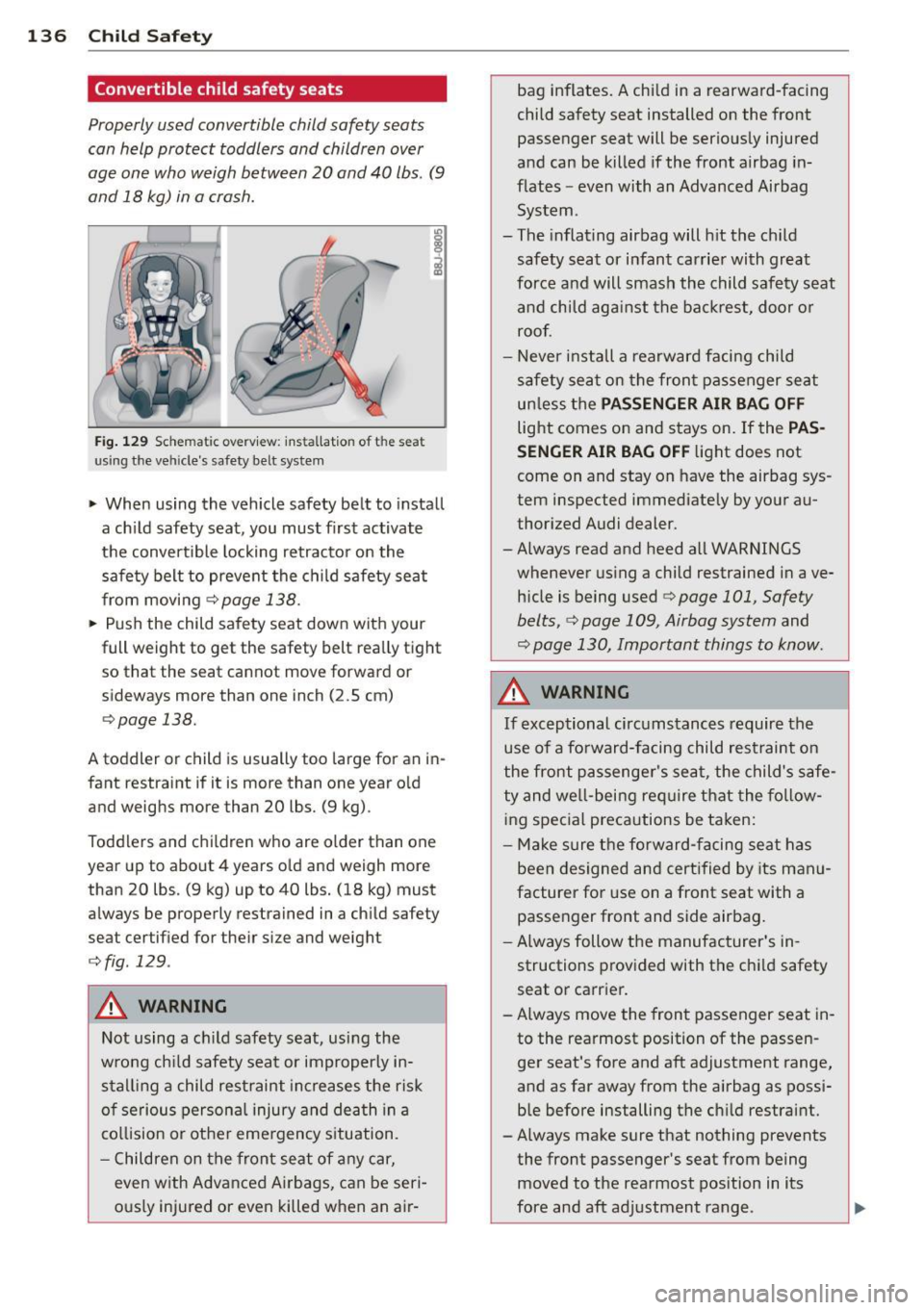
136 Child Safet y
Convertible child safety seats
Properly used convertible child safety s eats
can h elp protect toddlers and children over
age one who weigh between
20 and 40 lbs. (9
and 18 kg) in a crash.
Fig . 129 Schematic overv iew: installat ion of the seat
usin g the vehicle's safety belt system
~ When using the vehicle safety belt to install
a ch ild safety seat, you must first activate
the convertible locking retractor on the safety belt to prevent the c hild safety seat
from movi ng
Q page 138.
~ Push the child safety seat down with your
full weight to get the safety belt rea lly tight
so that the seat cannot move forward or
sideways more than one inch (2.5 cm)
Qpage 138.
A toddler or child is usually too large for an in
fant restraint if it is more than one year old
and weighs more than 20 lbs. (9 kg) .
Toddlers and ch ildren who are o lder than one
year up to about 4 years o ld and weigh more
than 20 lbs . (9 kg) up to 40 lbs. (18 kg) must
always be properly restrained in a child safety
seat certi fied for the ir size and weight
Q fig. 129.
&_ WARNING
Not using a ch ild safety seat, us ing the
w rong ch ild safety seat or improperly in
stal ling a child restraint increases the risk
o f se rious persona l injury and death in a
co llision or othe r eme rgency s ituation.
- Children on t he front seat of a ny car,
even w ith Advanced A irbags, can be seri
ous ly injured or even killed when an air -bag inflates. A chi
ld in a rearward-facing
child safety seat installed on the front
passenger seat will be seriously injured
and can be killed if the front airbag in
flates -even with an Advanced Airbag
System .
- The inflating airbag will h it the ch ild
safety seat or infant carrie r with great
for ce and will smash the child saf ety seat
and child aga inst the ba ckrest, door o r
roof .
- Neve r install a rearward facing child
safety sea t on the fron t passenger seat
un less t he
PASSENGER AIR BAG OFF
light comes on and stays on. If the PAS
SENGER AIR BAG OF F
light does not
come on and stay on have the airbag sys
tem inspected immediately by your au
thorized Audi dealer.
- Always read and heed all WARNINGS
whenever us ing a child restrained in ave
h icle is being used
¢ page 101, Safety
belts,
Q page 109, Airbag system and
Q page 130, Important things to know .
&_ WARNING
--
If exceptional circumstances require the
use of a fo rward-facing child restraint on
the front pa ssenger 's sea t, the child's safe
ty and we ll-bei ng req uire t hat the fo llow
i ng spec ial precautions be taken:
- Make sure the forward- facing seat has
been designed and cert ified by its man u
facturer for use on a front seat with a
passenger front and side airbag.
- Always follow the manufacturer 's in
structions p rovided with the chi ld safety
seat or carrie r.
- A lways move the front passenger seat in
to the rearmost position of the passen ger seat's fore and aft adjustment range,
and as far away from the airbag as possib le before installing the ch ild restraint.
- Always make sure that nothing prevents
the front passenger 's seat from being
moved to the rearmost position in its
fore and aft adjustment range .
Page 139 of 236
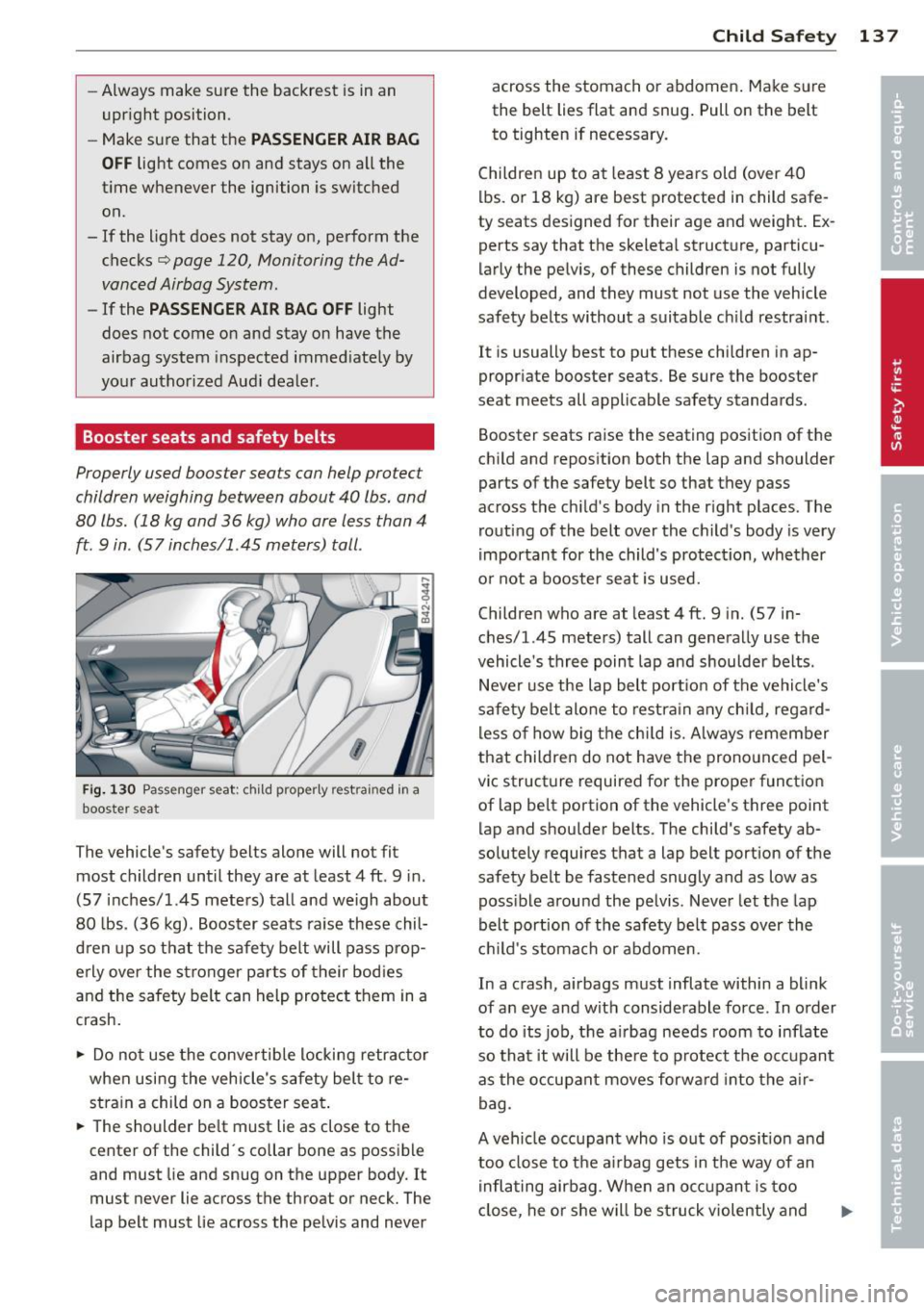
-Always make sure the backrest 1s in an
upr ight position.
- Make sure that the
PASSENGER AIR BAG
O FF
light comes on and stays on all the
t ime whenever the ignition is switched
on.
- If the light does not stay on, perform the checks¢
page 120, Monitoring the Ad
vanced Airbag System.
- If the PAS SEN GER AIR BAG OFF light
does not come on and stay on have the
airbag system inspected immed iately by
your authorized Aud i dealer.
Booster seats and safety belts
Properly used booster seats can help protect
children weighing between about 40 lbs. and
80 lbs. (18 kg and 36 kg) who are less than 4
ft. 9 in . (57 inches/1 .45 meters) tall .
Fig. 130 Passenger seat : child proper ly rest ra in ed in a
booster seat
The vehicle's safety belts alone will not fit
most children until they are at least 4
ft . 9 in .
(57 inches/1.45 meters) tal l and weigh about
80 lbs. (36 kg). Booster seats raise these chil
d ren up so that the safety belt will pass prop
erly over the stronger parts of their bod ies
and the safety belt can help protect them in a
crash .
• Do no t use the convertible locking retractor
when using the vehicle's safety belt to re
strain a child on a booster seat.
• The shoulder be lt must lie as close to the
center of the child · s collar bone as possible
and must lie and snug on the upper body.
It
must never lie across the throat or neck. The
lap belt must lie across the pelvis and never
Child S afety 13 7
across the stomach or abdomen . Make s ure
the belt lies flat and snug . Pull on the belt
to tighten if necessary.
Children up to at least 8 yea rs old (over 40
lbs. or 18 kg) are best protected in child safe
ty seats des igned for their age and weight. Ex
perts say that the skeletal structure, particu
larly the pelvis, of these children is not fully
developed, and they must not use the vehicle
safety belts without a suitable ch ild restra int .
It is usually best to put these chi ldren in ap
propriate booster seats. Be sure the booster
seat meets all applicable safety standards .
Booster seats raise the seating position of the
child and reposition both the lap and shoulder
parts of the safety belt so that they pass
across the ch ild's body in the r ight places . The
rout ing of the belt over the child's body is very
important for the child's protect ion, whether
o r not a booster seat is used.
Children who are at least 4
ft. 9 in. (57 in
ches/1.45 meters) tall can generally use the
vehicle's three point lap and shoulder belts .
Never use the lap belt port ion of the vehicle's
safety belt alo ne to rest ra in any ch ild, regard
l ess of how big the ch ild is. Always remember
that children do not have the prono unced pel
vic structure required for the prope r funct ion
of lap belt portion of the vehicle's three point lap and shou lder belts. The child's safety ab
solutely requires that a lap belt portion of the
safety belt be fastened snugly and as low as poss ible around the pelvis. Never let the lap
belt portion of the safety belt pass over the
c hi ld's stoma ch or abdomen.
In a crash, a irbags must inflate within a blink
of an eye and with considerable force . In order
to do its job, the a irbag needs room to inflate
so that it will be the re to protect the occupant
as the o ccupant moves forwa rd into the a ir
bag .
A vehicle occ upant who is out of posit io n and
too close to the a irbag gets in the way of an
inflating airbag . When an occ upant is too
cl ose, he or she will be struck violently and
Ill>
Page 140 of 236
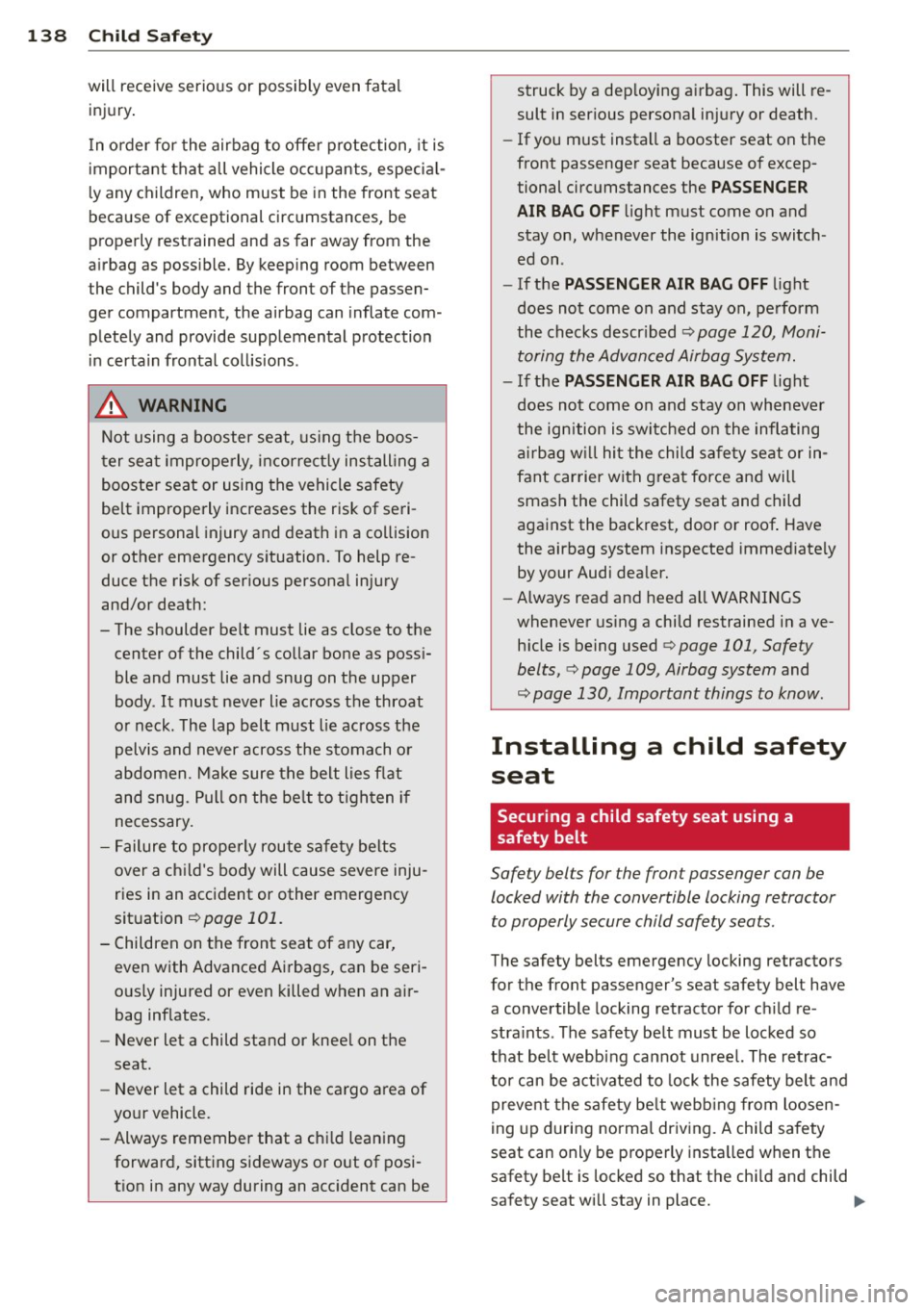
138 Child Saf ety
will receive serious or possibly even fata l
injury .
I n o rder for the airbag to offe r protection, it is
important that all vehicle occ upants, especia l
l y any children, who must be in the front seat
because of exceptional circ umstances, be
properly restrained and as far away from the
a irbag as poss ible. By keep ing room between
the child's body and the front of the passen
ger compartment, the airbag can inflate com
p letely and provide supplemental protection
in certain frontal col lisions.
_& WARNING
Not using a booster seat, using the boos
t er sea t imprope rly, incorre ct ly ins talling a
booste r seat or using the vehicle safety
belt improperly increases the risk of se ri
ous personal injury and death in a collision
or other eme rgency s ituation. To help re
duce the risk of ser ious persona l injury
and/or death:
- The shoulder be lt must lie as close to the
center of the child 's collar bone as poss i
ble and must lie and snug on the upper
body. It mus t never lie across the throat
o r neck . The lap belt must lie across the
pelvis and never across the stomach o r
abdomen. Make sure the belt lies flat
and snug. Pull on the be lt to t igh ten if
necessary.
- F ailure to properly route sa fety belts
over a ch ild' s body will cause severe inju
ries in an acc ident or other emergency
situation
<:!;,page 101.
- Children on the front seat of any car,
even w ith Advanced A irbags, can be seri
o usly injured or even killed when an a ir
bag inflates.
- Never let a child stand or knee l on the
seat.
- Never let a child ride in the ca rgo a rea of
yo ur vehicle.
- Always remember that a chi ld leaning
forward, sitt ing s ideways or out of posi
t ion in any way during an acc ident can be
-
struck by a dep loying a irbag . This will re
sult in ser ious personal injury or death .
- If you must install a booster seat on the
front passenger seat because o f excep
tional circ umstances the
PASSENGER
AIR BAG OFF
li ght must come on and
stay on , whenever the ignition is switch
ed on .
-If the PASSENGER AIR BAG OFF light
does not come on and stay on, pe rform
the ch ecks descr ibed ¢
page 120, Moni
toring the Advanced Airbag System .
-If the PASSENGER AIR BAG OFF light
does not come on and stay on whenever
the ig nit ion is switched on the infla ting
ai rb ag w ill hi t the child sa fe ty seat or in
fant car rier with g reat force an d will
smash the child sa fety seat and child
aga inst the backrest, door or roof . Have
the airbag system inspected immed iately
by your Audi dea ler.
- Always read and heed all WAR NIN GS
whenever using a child restrained in ave
h icle is being used
¢ page 101, Safety
belts,
¢ page 109 , Airbag system and
r:!;, page 130, Important things to know.
Installing a child safety
seat
Securing a child safety seat using a
safety belt
Safety belts for the front passenger con be
locked with the convertible locking retractor
to properly secure child safety seats .
The safety belts emergency locking retracto rs
for the front passenger's seat safety belt have
a convertible locking retracto r for child re
stra ints . The safety be lt must be loc ked so
that be lt webb ing cannot unree l. The r etrac
tor can be a ctivated to lock the safety belt and
prevent the s afety be lt webb ing from loosen
ing up d uring norma l dr iv ing. A child safety
seat can only be properly insta lled when t he
safety belt is locked so that the chi ld and child
safety seat will stay in place. ..,.